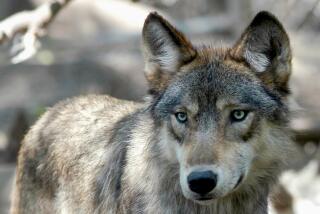The Arabian oryx — a comeback story
It’s a cool morning, and the Arabian oryx herd at the San Diego Zoo’s Safari Park is hungry and slightly hostile to the visitors in its midst.
The dominant male, known as No. 337, fixes a cold stare, lets out a loud snort and waggles his sharp horns, ready to protect his harem and offspring.
The females, with equally sharp horns, attempt to lead the visitors away from their babies, cat-sized creatures tucked in small crevasses in the ground.
It’s a matter of genetics: For eons, the herd’s ancestors roamed the Arabian Peninsula, honing their survival skills. But by 1972, the last wild oryx was reportedly killed by hunters in the Persian Gulf nation of Oman — leaving only a few of the animals in captivity.
What happened next was an unprecedented effort by the San Diego and Phoenix zoos to save the oryx from extinction through captive breeding. The animals were then released into the wild or protected reserves.
The Los Angeles Zoo was also involved in the oryx breeding program, sending four to Oman, eight to Israel and several dozen to U.S. zoos. The zoo has not had any oryx in its own collection since 2006.
This month, the International Union for Conservation of Nature upgraded the status of the Arabian oryx from “endangered” to “threatened.”
It was the biggest jump in rankings ever achieved by a species once considered extinct in the wild, according to officials at the Switzerland-based environmental group whose “red list” monitors the plight of struggling species.
The announcement was greeted with joy throughout the Arab world, where revival of the oryx is linked with national pride.
The desert antelope has a special place in Arab poetry and mythology — along with the cheetah, the falcon and the galloping horse. The oryx’s curved horns, seen from a certain side angle, appear to be a single horn, perhaps giving rise to the myth of the unicorn.
“To have brought the Arabian oryx back from the brink of extinction is a major feat and a true conservation success story, one which we hope will be repeated many times over for other threatened species,” said Razan Khalifa Al Mubarak, director general of the environmental agency in Abu Dhabi, capital of the United Arab Emirates.
The enthusiasm was shared by San Diego and Phoenix zoo officials.
“The oryx is what we call a flagship species,” said Dan Subaitis, director of animal management at the Phoenix Zoo.
Biologists say the oryx is a highly adapted species, with split hooves for traipsing the desert, white fur to reflect the brutal sun, and physiology for cooling the brain and surviving on precious little water.
But what the oryx could not survive was the advent of modern hunting methods: hunters with high-powered rifles and four-wheel-drive vehicles readily able to chase the animal over dunes and hard-packed sand.
Its numbers declined rapidly to the point of near extinction.
Thanks to captive breeding, however, the oryx was staging a comeback by the early 1980s. Bedouin tribesmen were tending to oryx that had been born in San Diego and released into the desert of Oman.
Then a burst of poaching in the late 1990s once again imperiled the animal. “It just cut the heart out of the people who were working with the oryx,” said Randy Rieches, curator of mammals at the Safari Park.
Instead of abandoning the save-the-oryx effort, the American zoos, along with the royal families of Oman, Saudi Arabia and Jordan and the government of Israel, redoubled efforts.
When Iraq invaded Kuwait in 1990, Iraqi soldiers stormed the Kuwait Zoo, grabbed its oryx and shipped it to Baghdad, reportedly on orders of Saddam Hussein. A U.S.-led coalition later ousted the Iraqis from Kuwait, but the stolen oryx never returned.
In 2006, the oryx was the official mascot of the Asian Games, hosted by the royal family in Qatar.
The Phoenix Zoo is working with the Shaumari Reserve near Azraq, Jordan; the San Diego Zoo is helping the Al Ain Wildlife Park and Resort in Abu Dhabi. The Saudis are protecting oryx in the Mahazat as-Sayd Protected Area.
San Diego Zoo officials are in negotiations to send another group of oryx to Oman, where Sultan Qaboos bin Said al-Said is personally directing the oryx revival.
The Safari Park — formerly known as the Wild Animal Park — has 31 oryxes, most of them in a large exhibit area. Some, mostly older males, are kept separate, lest they tangle with No. 337, who does not share his female mates.
Since the first arrivals in 1972, 346 oryxes have been born at the park, most sent on to their native lands or to other U.S. zoos. The San Diego Zoo has three “back-up breeding males.”
To Rieches, the lesson of the oryx is that conservation efforts should not be dropped just because of a setback. “You don’t walk away from a species,” he said.
More to Read
Start your day right
Sign up for Essential California for news, features and recommendations from the L.A. Times and beyond in your inbox six days a week.
You may occasionally receive promotional content from the Los Angeles Times.






